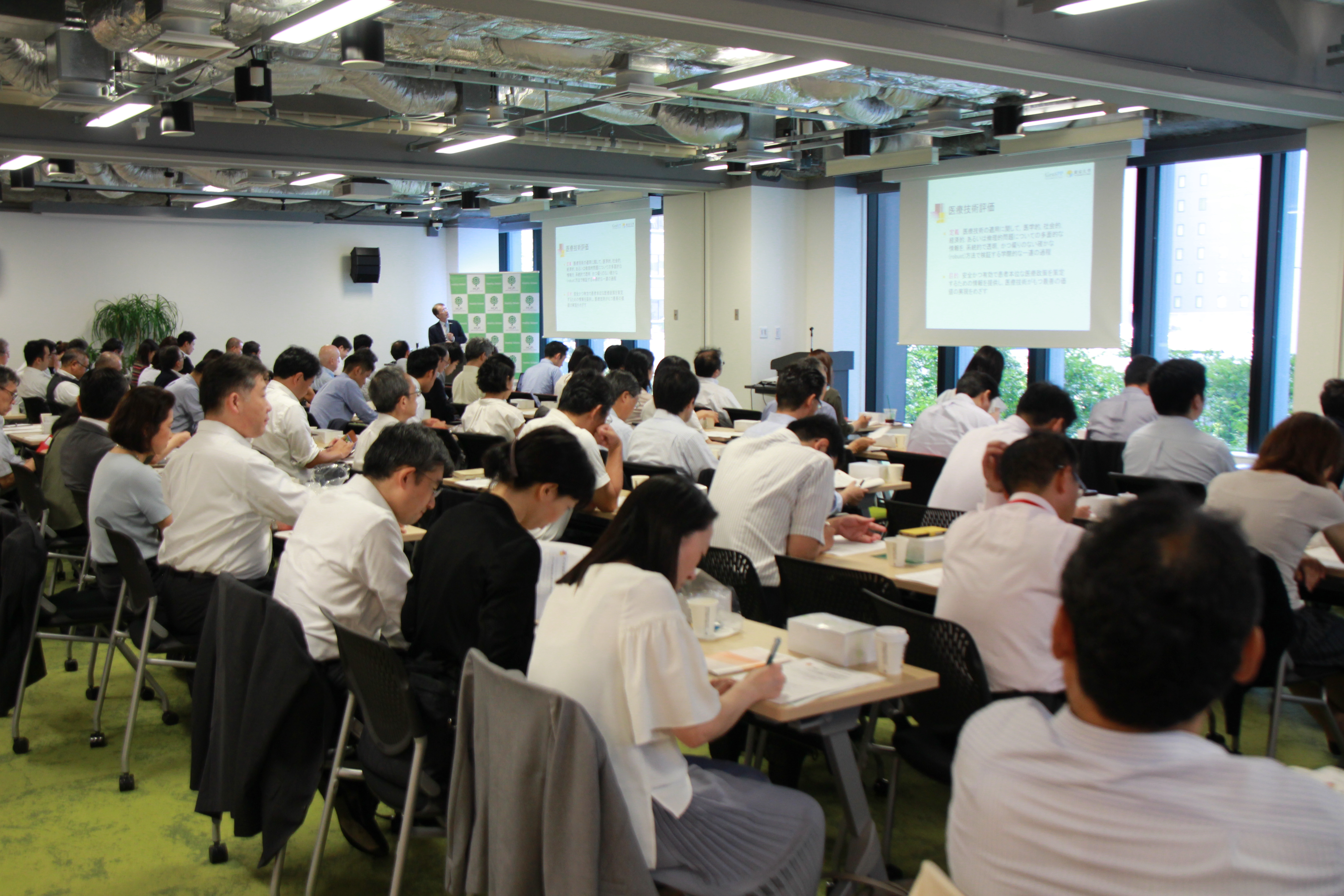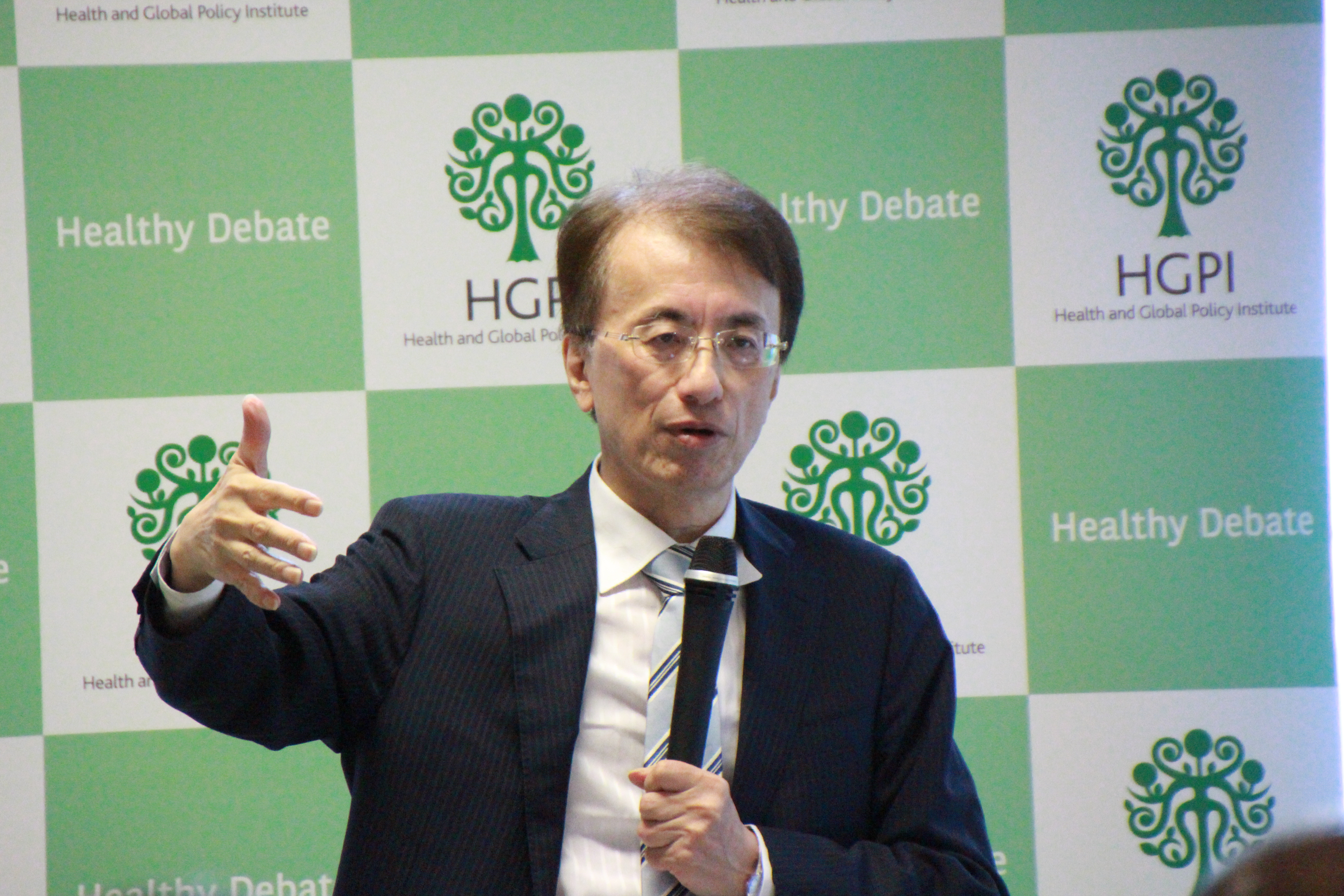[Event Report] The 71st Breakfast Meeting – Rebalancing Healthcare Systems: Innovation and Sustainability Series – The Challenges Facing Health Technology Assessment (HTA) and the Promise it Holds (August 22, 2018)
date : 10/21/2018
Tags: Future of the Health Care System, HGPI Seminar, Innovation and Sustainability
![[Event Report] The 71st Breakfast Meeting – Rebalancing Healthcare Systems: Innovation and Sustainability Series – The Challenges Facing Health Technology Assessment (HTA) and the Promise it Holds (August 22, 2018)](https://hgpi.org/en/wp-content/uploads/sites/2/BM71_1-1.jpg)
The creation of efficient and effective healthcare systems to ensure innovation and sustainability is a common issue for every country across the world, including Japan. Efforts are being made country by country to appropriately assess medical treatments. Health Technology Assessment (HTA) is one way to gauge the cost-effectiveness of healthcare systems and ensure the optimal allocation of resources. Discussions on the introduction of HTA have been held in Japan since 2012, particularly at the Committee for Cost-Effectiveness Assessment within the Central Social Insurance Medical Council (Chuikyo). A trial introduction of Cost-Effectiveness Assessment began in FY2016. Discussions about the full-scale introduction of these assessments are ongoing in FY2018.
Since 2016, HGPI has conducted a series of expert meetings entitled the “Rebalancing Healthcare Systems: Innovation and Sustainability” Forum Series to facilitate open discussions on HTA by bringing together multi-stakeholders from industry, government, academia, and civil society. Throughout these forums, we have worked to identify issues and provide policy recommendations.
For this Breakfast Meeting, we invited Project Professor Isao Kamae of the University of Tokyo’s Graduate School of Public Policy to talk about the debate surrounding the introduction of Cost-Effectiveness Assessment for the appropriate assessment of healthcare technologies as well as the challenges it faces and the promise it holds. HGPI also gave a brief briefly summary of its current project activities at the beginning of the meeting.
Summary of the Lecture
I have been involved in the field of HTA for about 15 years, since the first ISPOR Asia-Pacific Conference in Kobe in 2003. Current discussions for the full-scale introduction of HTA in Japan are progressing in a direction rarely seen in other parts of the world. I believe this is risky from an academic standpoint.
■ What is HTA?
Prior to HTA, emphasis was placed on transitioning to Evidence-Based Medicine (EBM) rather than relying on Experience-Based Medicine (EBM), which utilizes the experience of on-site healthcare professionals. By using HTA, we can go one step further and realize Value-Based Medicine (VBM). The use of HTA spread globally from the National Institute for Health and Care Excellence (NICE) in the UK. Since then, many public organizations for HTA have been established, mainly in Europe, and in 1993, the International Network of Agencies for Health Technology Assessment (INAHTA) was established. Japan is the only G7 country with no public HTA institution and not in INAHTA.
■ Discussions on Cost-Effectiveness Assessments should be objective and data-based
Recently in Japan, the effects of expensive treatments, particularly those used for cancer, have drawn criticism. However, examining data from the US shows that there are no problems with the cost-effectiveness of cancer treatments. Nevertheless, as there are no public institutions to conduct Cost-Effectiveness Assessments, and data has not yet been gathered, we cannot have evidence-based discussions. It is important that we discard our existing misconceptions and form new opinions based on data.
■ Use of Quality-Adjusted Life Year (QALY) in cost-effectiveness discussions
In the UK, coverage decisions and insurance payment amounts are decided based on Incremental Cost Effectiveness Ratio (ICER) calculated with Quality-Adjusted Life-Year (QALY). QALY is represented by a number that is calculated using two factors, quality of life and years of life. However, Germany and the US do not support the use of QALY. Current discussions in Japan are held with the assumption that QALY is a useful outcome indicator to determine price adjustments, but the use of QALY itself should also be carefully examined.
■ Difficulty of the analysis model
In the trial introduction of Cost-Effectiveness Assessments in Japan that began in FY 2016, analyses have been conducted using the Markov model[1]. However, researcher opinions vary on the validity of the analysis model in certain situations, such as when the simulation is conducted over a long period of time. An appropriate analytical model should be chosen based on statistical rationality.
[1] A model that classifies the prognosis into several stages and to simulate the probability of transitioning to those stages when the duration of illness is long, such as with chronic diseases
■ Problems with comprehensive assessment (Appraisal)
Based on discussions on Cost-Effectiveness Assessments held by Chuikyo, comprehensive assessments are to be conducted on the results of Cost-Effectiveness Assessments obtained by companies and reanalysis groups to evaluate (1) scientific validity of the analysis results and (2) ethical and social impacts.
This is planned to be done by reducing the ICER value by the additional cost required to achieve an extension of 1QALY. As this approach has not yet been academically established, it might be more appropriate to raise or lower the ICER criteria.
Additionally, the current method – in which price adjustment relies only on ICER – is not scientific. Since baseline data selection greatly affects assessment results, the current method can lead to manipulated results.
■ Can MCDA be utilized for comprehensive assessment?
In Multiple Criteria Decision Analysis (MCDA), multiple criteria can be used with the same scale, making them transparent and objective. The current comprehensive assessment can be subjective in practice, and MCDA can be a means for preventing this.
On the other hand, this can make it challenging to secure and train experts who can present, evaluate, and improve the analysis model. Furthermore, there are various technical limitations, such as securing the highly reliable data needed for analysis, verifying the validity of scoring and weighting, and evaluating the validity of analysis results.
■ The future direction of HTA
The central premise for HTA is to contribute to the development of sustainable healthcare insurance systems. The importance of sustainability is now widely acknowledged, but it is rare to see cases in which practical methods for achieving it are specified. Value is not commonly included when discussing the balance between benefits and burdens. Additionally, the ICER-focused Cost-Effectiveness Assessment has limitations on value judgment, including various peripheral effects caused by the use of new medical technology.
We need to consider the balance between cost increases due to positive investment (such as the approval/reimbursement of new drugs, increases in drug premiums, and expansions of drug applications) and cost reductions due to negative investment (such as revisions of medical treatment fees, price differentiation, and price reduction by Cost-Effectiveness Assessment). While doing this, it is critical to establish a two-state circulatory model that moves between affordable financial situations and unaffordable financial situations.
■ Prof. Isao Kamae
In his capacity as Project Professor at the University of Tokyo’s Graduate School of Public Policy, Professor Kamae heads the research unit on healthcare policies and technology assessment. In addition to his role at the University of Tokyo, he is research director at the Canon Institute for Global Studies. He holds an M.S. in Information Science from Kyoto University, an M.D. from the Kobe University School of Medicine, an M.S. in Biostatistics as well as a PhD in Health Decision Science both from Harvard School of Public Health, making him the first Japanese national to obtain a PhD in this discipline. He is also a director at the International Society for Pharmaeconomics and Outcomes Research, and Health Technology Assessment International. He also assumes roles in international organizations, including expert committees at the WHO and the OECD.


日本語
Top Research & Recommendations Posts
- [Report and Recommendations] Discussion Points in Healthcare DX Project Expert Panel Meeting (April 2, 2024)
- [Policy Recommendations] Kidney Disease Control Promotion Project 2023 “Establishing Kidney Disease Control Measures with Patient, Citizen, and Community Engagement and Collaboration” Policy Recommendations, a Collection of Good Practices of Chronic Kidney Disease (CKD) and Control Measures in Local Governments (February 14, 2024)
- [Announcement] A Significant Step Towards the Building a Green Healthcare System: Support for the Formal Expression of Interest by the Japanese Government Delegation to the ATACH at the Executive Board Meeting of the WHO (February 16, 2024)
- [Event Report] Planetary Health Expert Meeting Aiming for Sustainable Healthcare: Learning from the Impact of Environmental Pollution and Medical Waste During the Pandemic (February 16, 2024)
- [Research Report] Survey of Japanese Physicians Regarding Climate Change and Health (December 3, 2023)
- [Policy Recommendations] Dementia Prevention Initiatives for Achieving a Dementia-Friendly and Inclusive Society (March 26, 2024)
- [Research Report] 2019 Survey on Healthcare in Japan
- [Research Report] Building a Mental Health Program for Children and Measuring its Effectiveness (June 16, 2022)
- [Policy Recommendations] Three Necessary Perspectives for Formulating the Basic Plan for the Promotion of Policies on Dementia: Creating a Society That is Inclusive for All People at All Times (April 1, 2024)
- [Policy Recommendations] Establishing an integrated care system for pain from the perspectives of people with lived experience (March 29, 2024)
Featured Posts
-
2024-04-02
[Report and Recommendations] Discussion Points in Healthcare DX Project Expert Panel Meeting (April 2, 2024)
![[Report and Recommendations] Discussion Points in Healthcare DX Project Expert Panel Meeting (April 2, 2024)](https://hgpi.org/en/wp-content/uploads/sites/2/20240411.png)
-
2024-04-08
[Event Report] HGPI Participates in the Connecting Climate Minds Global Event (March 19-21, 2024)
![[Event Report] HGPI Participates in the Connecting Climate Minds Global Event (March 19-21, 2024)](https://hgpi.org/en/wp-content/uploads/sites/2/HGPI-Participates-in-the-Connecting-Climate-Minds-Global-Event_240319.png)
-
2024-04-08
[Registration Open] The 124th HGPI Seminar “Reconsidering Infectious Disease Control Strategies Centering on Vaccination and Immunization – From the Experiences of the COVID-19 Pandemic and a Life Course Approach” (April 26, 2024)
![[Registration Open] The 124th HGPI Seminar “Reconsidering Infectious Disease Control Strategies Centering on Vaccination and Immunization – From the Experiences of the COVID-19 Pandemic and a Life Course Approach” (April 26, 2024)](https://hgpi.org/en/wp-content/uploads/sites/2/HGPI_20240426_124thHGPISeminar_rev.png)
-
2024-04-10
[Research Report] “International comparison of dementia policies, research study on information dissemination.” (April 10, 2024)
![[Research Report] “International comparison of dementia policies, research study on information dissemination.” (April 10, 2024)](https://hgpi.org/en/wp-content/uploads/sites/2/dementia-20240410-top.png)
-
2024-04-11
[Research Paper] “Exploring the Potential of Industry-Academia-Civil Collaboration for Sustainability in the Healthcare Sector” Published in Journal Society for Environmental Economics and Policy Studies (March 31, 2024)
![[Research Paper] “Exploring the Potential of Industry-Academia-Civil Collaboration for Sustainability in the Healthcare Sector” Published in Journal Society for Environmental Economics and Policy Studies (March 31, 2024)](https://hgpi.org/en/wp-content/uploads/sites/2/ph-20240331-top.png)




